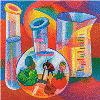Chemical and Biomolecular Engineering Research and Publications
Date of this Version
April 2000
Abstract
Recent devclopments in recombinant DNA technology have enabled the synthesis of valuable therapeutic proteins in bacterial cells as well as in novel eucaryotic expression systems. However, the purification of proteins of interest from either the conventional sources, cell culture, or novel routes in a highly purified form necessitates the development of separation tcchniques capable of recovering proteins from these feed streams in a highly purified form (1,2). Purification of therapeutic proteins from biological sources is usually complicated by the presence of endogenous proteins (2). Purification methodologies based on ion exchange or adsorption serve as excellent prepurification steps, but they fail to resolve complex protein mixtures to yield a homogeneous protein tein product (l).P urification techniques based on affinity interactions between molecules (i.e., immunoaffinity chromatography, IAC) have rapidly evolved using a variety of biological and synthetic ligands (2).


Comments
This article was published in Methods in Molecular Biology Vol. 147. Affinity Chromatography: Methods and protocols Series: Methods in Molecular Biology, Published by Humana Press Inc. © 2000. Pub Date: April 2000. Pages: 240 ISBN: 1-59259-041-1 DOI: 10.1226/0896036944.Visit Humana Press